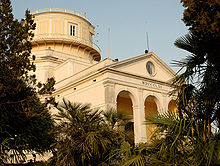Lisbon observatory
| Astronomical Observatory of Lisbon | |
|---|---|
| Foundation, endowment | 1861 |
| director | Professor Rui Jorge Agostinho |
| Sub-director | Professor Paulo Crawford |
| location |
Lisbon Alcântara Tapada da Ajuda |
| website | Lisbon Astronomical Observatory |
The Lisbon Observatory (Observatório Astronómico de Lisboa) is an institution that was internationally recognized from the 19th to the 20th centuries for its work in the field of positional astronomy . In 1992 the institution was attached to the University of Lisbon and in 1995 it was integrated into the Faculty of Science.
history
The observatory was created in the course of a controversy between the French astronomer Hervé Faye (1814–1902) and Wilhelm Struve (1793–1864), director of the observatory in Pulkowo near Saint Petersburg , over the determination of the parallax of the star Groombridge in 1830 . Lisbon was the only place on the European continent where it was possible to observe this star, discovered by Friedrich Wilhelm Argelander , with a particularly precise zenith refractor . The construction was supported by King Pedro V and other personalities.
The foundation stone was laid on March 11, 1861. King D. Luis I contributed to the success of the project through payments from his personal treasury. Astronomical observations began at the observatory in 1867, and it was officially founded on May 6, 1878 by decree.
The construction plans were closely based on the construction of the observatory in Pulkowo and were designed by the French architect Jean Colson . Wilhelm Struve offered his services to the Portuguese government and became the most important and influential advisor. He led the astronomer Frederico Augusto Oom and advised him over a period of around 5 years. Oom, a former lieutenant in the navy and hydrographic engineer , became the observatory's first director.
The observatory took part in several international campaigns, in particular 1900-1901 in the international campaign to determine the astronomical unit (AU) by means of the opposition of the newly found asteroid Eros . The director of the observatory, Campos Rodrigues, and other astronomers at the house were involved in the creation of a catalog of reference stars. In 1904 Campo Rodrigues received the Valz Prize for Astronomy from the French Academy of Sciences for the excellent work that had been done in Lisbon under his direction.
The tasks of the observatory also include determining the official Portuguese time, which used to be measured with precise pendulum clocks and controlled with the help of astronomical observations. The time signal was broadcast by light telegraph . Today the time is determined by the observatory using atomic clocks and distributed over the Internet .
The historic building of the observatory is now used mainly as a museum, for didactic tasks and public relations . Current research at the observatory is based on data obtained from major observatories around the world or from observation satellites .
building
The observatory is located in the park of the Tapada da Ajuda, a former royal hunting area on the hills of the Serra de Monsanto above the Alcântara district , which today houses the Agricultural Institute of the University of Lisbon .
It was built as a central building with a view of the Tejo , the entrance area with the classical main facade with a large triangular gable facing south. The central, circular main room supports the observation room of the observatory above via eight large columns and a richly elaborated vault. In the arches between the columns, there are many historical pendulum clocks that were used to measure the official time in the observatory. In front of the large windows of the room there are large tables at which the astronomers developed their research. The large equatorial - refractor is housed in a cylindrical roof cap, the flat dome and side walls, the Meridian Lisbon following can be opened from the north to south.
In the other three wings of the building to the west, north and east there are further spacious observation rooms at the end, which have doors in the walls and their own observation openings in the roof. Towards the main building there are other rooms that were used for teaching purposes, calculations and other tasks; Today, didactic tasks such as project groups and work with school children take place here. Two more, much smaller, domes with observation instruments lie south of the building.
The observation rooms are equipped with wood paneling that is permanently ventilated from the outside , which, in the interests of the accuracy of the measurement results, is supposed to adjust the inside and outside temperatures; the other rooms are ventilated, somewhat less expensively, via chimneys in the roof.
Museum and instruments
The historical observatory is operated by the museum of the observatory. In the museum area, various astronomical instruments are shown and explained, all of which are still fully functional.
There is a new platform for the large equatorial refractor , built in Nice in 1990, which is equipped with a modern micrometer for studying binary stars. However, it is not connected to the telescope.
literature
- Volker Witt: An observatory for Argelander's star. The Lisbon observatory. In: Stars and Space . March 2008, pp. 92-97 ( PDF ).
Web links
- Website of the Observatório Astronómico de Lisboa (Portuguese)
- Observatório Astronómico de Lisboa in the Sistema de Informação para o Património Arquitectónico (Portuguese)
Individual evidence
- ↑ cf. Prize Awards of the Paris Academy of Sciences. In: Nature. Vol. 71, H. 1835, 1904, pp. 214-215.
Coordinates: 38 ° 42 ′ 37.9 ″ N , 9 ° 11 ′ 15 ″ W.
